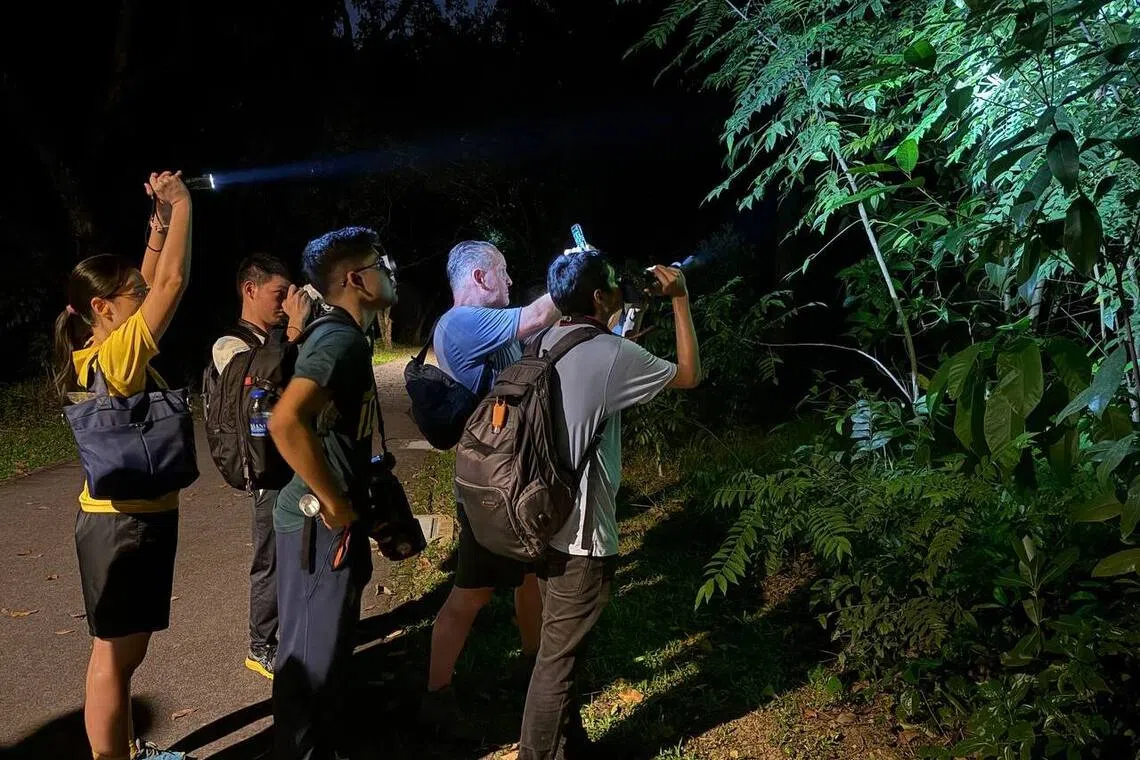Grant for projects on reptiles, amphibians in Singapore to be launched by volunteer group
Sign up now: Get ST's newsletters delivered to your inbox

Volunteer group Herpetological Society of Singapore manning a booth to teach the public about reptiles and amphibians.
PHOTO: KANNAN RAJA
Follow topic:
SINGAPORE – A grant of $2,000 to fund projects on reptiles and amphibians here annually by students and emerging scientists will soon be launched by the Herpetological Society of Singapore (HSS).
The volunteer group’s president Kannan Raja told The Straits Times that the kitty will support niche, small-scale ideas linked to herpetofauna, dubbed affectionately by enthusiasts as “herps”.
The society plans to roll out the grant by January 2026 to fund these initiatives that promote public outreach, citizen science or ecological research.
The no-strings-attached grant will support projects that tend to fall through the cracks during applications for grant frameworks that cater to large-scale research or broader biodiversity themes.
“While Singapore already has excellent grant frameworks, they often cater to larger-scale research or broader biodiversity themes,” said Mr Kannan, 34.
“The HSS fund is designed to be nimble, accessible and targeted to support herp-related initiatives without excessive bureaucracy.”
Undergraduates and postgraduates from local institutes of higher learning will be able to apply for funding of up to $1,000 each.
Singapore boasts a rich diversity of reptiles and amphibians, numbering 166 species, of which 17 are non-native.
“The idea originated from years of observing our members and students who approach us, brimming with ideas but lacking the resources to execute them,” said Mr Kannan, who set aside the $2,000 sum from sales of the society’s stickers, posters and pins.
“Creating this fund was a natural step in HSS’ evolution, moving from conducting our own projects to empowering our followers and upcoming herpetologists to carry this forward.”
He was speaking ahead of the society’s 10th anniversary celebration on Oct 4 at NUS’ Lee Kong Chian Natural History Museum.
HSS began as a Facebook group in April 2015, after six young people felt that Singapore’s reptiles and amphibians needed greater recognition and conservation.
The group, composed of mostly undergraduates and young professionals, started conducting free guided walks for the public in their spare time, recalled the society’s first president, Mr Sankar Ananthanarayanan.
Today, the group has grown into a collective of 43 students, researchers, nature enthusiasts and educators like Mr Kannan, a teaching assistant at NUS.
Beyond walks and talks, the society contributes to the understanding of local reptiles and amphibians through free resources such as a library of Singapore’s frog calls
Said Mr Kannan: “For many Singaporeans, it has been eye-opening to realise that the ‘background noise’ of post-downpour drains is actually a symphony of distinct species – the look of recognition that dawns on people’s faces when you play them the call of a banded bullfrog is quite entertaining.”
Beyond recognition, HSS’ second president hopes the society’s data will guide conservation decisions.
For example, preliminary findings of a roadkill study
This is likely due to opportunities to bask in the sun, and the reptiles being more active during warmer weather, said Mr Kannan.
Herps are especially vulnerable to being killed by vehicles, as they often move slowly, and their cold-blooded bodies are drawn to the warmth of concrete and asphalt roads.
An early analysis of the current findings is also starting to reveal a picture of where such roadkill tends to occur, with Old Upper Thomson Road and Rifle Range Road being two examples of hot spots, said Mr Kannan.
The society plans to share the finalised study with the authorities to inform measures to prevent such incidents, which could include fencing and wildlife crossings.
Deputy director of NUS’ Centre for Nature-based Climate Solutions Adrian Loo lauded the society’s efforts to engage the public with good science, which has made it easier for people who could be overwhelmed by the complexity and science of Singapore’s natural history.

Volunteer group Herpetological Society of Singapore conducting a guided nature walk about reptiles and amphibians.
PHOTO: SHIVARAM RASU
Citing the society’s project for reporting roadkill, Associate Professor Loo said: “I think many in Singapore want to play their part, and HSS is providing a way for citizen science to flourish in an accessible manner, undergirded with good science.”
Mandai Nature and Mandai Wildlife Group veterinarian Charlene Yeong highlighted the key role that the society has played in changing the narrative on snakes and other reptiles, which are often misunderstood and overlooked.
Over the past decade, its contributions have also acted as a voice for Singapore’s reptiles and amphibians during high-profile skirmishes with humans, such as when a reticulated python was hacked to death at a market in 2023, and another was reportedly burned alive
Dr Yeong, who is part of the panel that will review applications for the grant, said: “This new grant will fuel and support much-needed research and conservation of these fascinating yet vulnerable wildlife.”
Mr Sankar, 30, said the grant will mirror those offered by herpetological societies elsewhere.
“They can help to incentivise students who are interested to work on these amazing and misunderstood animals to take the leap and get started on their own scientific careers,” he added.
But there are still unfulfilled dreams for Mr Kannan.
He said: “I would like the society to continue contributing robust data towards shaping biodiversity management, normalise reptiles and amphibians as part of Singapore’s natural heritage and to connect with our counterparts in South-east Asia, since conservation challenges rarely stop at the borders.”


